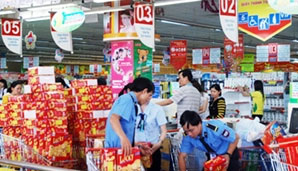Retail market enters fierce competition
However, the ratio of Made-in-Vietnam products to imports remains modest given the great potential of a market of nearly 90 million consumers. Vietnamese products lose out to imports, especially contraband goods, on the home market.
Inefficient distribution network
An
uneven distribution system is one main issue hindering the development of the
retail market, says Dr Pham Tat Thang, a senior market researcher of the
Ministry of Industry and Trade.
Statistics show that in 2010 Vietnam had more than 450 supermarkets, 80 trade centres, over 2,000 convenience stores and approximately 8,600 traditional markets. Only 15-20 percent of retail sales came from the modern trading system, while 40 percent was generated from traditional markets and the remainder from private street traders.
Several companies with popular brand names such as Garment 10, Viet Tien Garment, Nha Be Garment, Trung Nguyen Coffee, Vinamilk and Kinh Do Cookies have developed distribution networks across the country. Yet, they are just a drop in the ocean for a large, potentially lucrative market like Vietnam.
The fact is that Vietnamese products make up a large proportion of goods in leading supermarkets such as Big C, Hapro, and Saigon Co.op. However, they have yet penetrated traditional wholesale markets including Dong Xuan in Hanoi, Rong in Nam Dinh city, Dong Ba in Hue city, Han in Danang city, and Ben Thanh in HCM City. These markets are regarded as ideal for low-cost Chinese goods which are then distributed to smaller markets and private traders across the country.
Dr Thang says it is time to apply a comprehensive vision of the goods distribution network to supply Made-in-Vietnam products to the wider consumer community.
During WTO negotiations, Vietnam tried to claim several rights protecting the interests of small traders. One of those rights was the Economic Needs Test (ENT), with which foreign distributors have found it difficult to enter the Vietnamese market en mass. In its White Book, the European Chamber of Commerce (Eurocham) in Vietnam even described ENT as a key market accessibility obstacle for investors.
In the near future, ENT and other technical barriers will be removed and domestic distributors will face fierce competition from abroad. One feasible solution, according to Dr Thang, is to make the most of the nation’s 22.8 million internet users and more than 120 million phone subscribers to develop sales channels for Vietnamese products.
Mounting pressure
Dr Thang points to the fact that contraband goods imported from China are cornering Vietnam’s retail market. He quotes world economic experts as saying no country in the world can compete with Chinese goods in terms of price, and Vietnam is no exception.
It is worth remembering that several decades ago many Chinese goods such as Wanli beer, china, vacuum flasks, electric fans and clothes flooded the Vietnamese market. After Vietnam restructured domestic production, improved product quality and ensured food safety and hygiene, Vietnamese products gradually won consumer trust and regained the lion’s share of the market. To date, no bottles of Wanli beer are sold in Vietnam. Hanoi and Saigon beer, Ming Long and Hai Duong china, Rang Dong vacuum flasks, Dien Co electric fans, and Viet Tien, Garment 10 and An Phuoc clothing are now favourites with local consumers.
It is obvious that local consumers do not turn a blind eye to Vietnamese products if manufacturers respect and seek to cater to their diverse tastes. Businesses are advised not to look for support from the State but to unite and quickly adapt to market demand. In addition, consumers are required to be clever to protect themselves against products of unknown origin. Only when local businesses and consumers are aware of this, will Vietnamese products truly gain a firm foothold on the domestic market.
(VOV)
 Bank encourages checking transactions on applications
Bank encourages checking transactions on applications
 Ben Cat concentrates efforts to fulfill socio-economic development targets
Ben Cat concentrates efforts to fulfill socio-economic development targets
 Forstering a logistics center with regional connection
Forstering a logistics center with regional connection
 To clear bottlenecks, make good use of FTAs
To clear bottlenecks, make good use of FTAs
 Vietnam balances supply and demand to prepare for Tet shopping season
Vietnam balances supply and demand to prepare for Tet shopping season
 Developing Bac Tan Uyen district into a town in the period 2030-2040
Developing Bac Tan Uyen district into a town in the period 2030-2040
 Accompanying investors for sustainable development
Accompanying investors for sustainable development
 Tan Uyen: Flexible adaptation, stable growth
Tan Uyen: Flexible adaptation, stable growth
 Tax revenue management boosted and modernized
Tax revenue management boosted and modernized
 To build synchronous infrastructure, facilitate new era development
To build synchronous infrastructure, facilitate new era development







